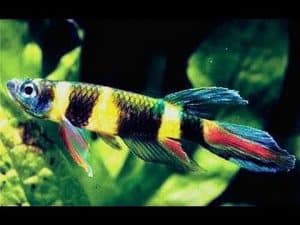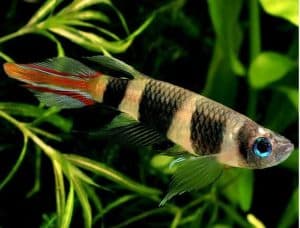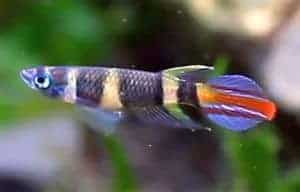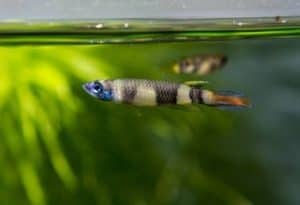Last updated on June 4th, 2023 at 07:12 pm
The clown killifish, also known as rocket killifish or epiplatys annulatus, has a bright orange color and is found in areas where there are underwater pinnacles. They live for about three years on average but can survive up to eight months without food or water under the right conditions (they do not need much oxygen). The fish population changes depending on how long it spends near the surface.
Clown killifish are small, brightly-colored fish. They live in the Amazon Basin and parts of northern South America (Brazil to Venezuela). Clown Killies was first observed by biologists in 1887 when they collected some specimens from an area near Iquitos, Peru.
Origin of the name

There are a few theories on how the killifish acquired its cutesy nickname. One theory is that fishermen called them “killies” because they would frequently have to throw back these little fish in order to be within legal limits before their boat was weighed at the port. Another theory states that these fishes were once popular bait for commercial fishermen and were known as “clowns” because they would put on a show around the fisherman. This name became more widely associated with killifish in Australia, where these fish are abundant.
At any rate, it is unknown exactly how this animal got its current designation of “killifish.”
The clown killifish is a small, colorful species of fish found primarily in the countries surrounding Australia. It has been introduced to other areas through accidental or intentional releases and some populations have since become established as invasive pests outside their native range.
Species profile
The clown killifish is an amazing little creature! Growing to only about three inches long, the male killifish spends most of its time guarding and nest building for their young. They are not picky eaters and will accept nearly any live prey offered.
Clown Killies get their name from their brightly striped fins. They come in many different colors, and some have a cross pattern to their stripes.
There are two types of clown killifish: the “true” killies which live solely on land, and those that also swim in the water. When under attack from an enemy, they spit out distasteful goo at them!
The clown killifish is a great little fish to keep in an aquaponics system. They are easy to care for and will not grow too big, so they fit well into small spaces like tanks or bowls. If the water gets low enough (about two inches) they can survive out of water for up to 15 minutes!
Color and appearance
Clown killifish are typically a reddish-orange color, with large white spots on their sides. These fish come from the Western Pacific Ocean and Eastern Indian Ocean regions. The males grow up to about two inches in length, while females can be as long as four inches. Clown killifish have an elongated body shape that is deep, flat, and almost leaf-like. They are often found at the bottom of protected reefs with lots of coral growth or under ledges where they can find shelter from predators.
Habitat
The killifish live in a variety of habitats that can range from streams to wetlands with thick vegetation to pools on the muddy ground. The species is usually found near mud or silt-covered sections of water where it spends its time hiding under plants just below the surface.
Clown killifish live in a variety of habitats that can range from streams to wetlands with thick vegetation. Clowns prefer these waters because they offer ample plant cover on which fry can feed; however, most species are found in the shallow, vegetated areas of lakes and ponds.
The clown killifish is widespread in North America, inhabiting lakes and ponds as well as slow-moving sections of streams. They also occupy swampy areas that are subject to seasonal flooding at the margins of their range.
Clown killifish size
The clown killifish is a small freshwater fish that typically grows to about 25mm in length.
The size of the clown killifish is approximately three inches. This fish is a member of the Cyprinodontidae family, which also includes some other types of small-bodied freshwater fishes like livebearers and tooth carps.
Clown killifish tank size
The clown killifish requires at least a 30-gallon tank. If you have multiple fish, then the larger the better as they need plenty of room to move around and establish territory; otherwise fights will break out between them. A 20-gallon long or even a 40-gallon tall would be suitable for one small group of these fish.
A 30-gallon tank is suitable for up to six fish, and a 55 gallon long will suit one small group of clown killifish. A 75-gallon or larger aquarium would be necessary if you want more than two groups in the same tank; there should also be some branching plants like Java ferns scattered throughout the tank to help give the fish adequate hiding places.
Life cycle
The life cycle of the clown killifish is very short. One month after spawning, there may be as many as 100 fries in a small population – sometimes even more than 500 per square meter. However, typically, only one-fifth to one-third of these fish will survive into adulthood due to predation from other species and decreases in water quality.
Are clown killifish aggressive or peaceful?
Clown killifish are fairly peaceful. They do not have much of aggressive nature and will typically flee from potential predators rather than fight back. The only exception is when they are protecting their eggs or fry in the nest, but even then they won’t attack aggressively for long before retreating to safety.
Some species of clown killifish are even more peaceful and will actually ignore or flee from potential predators.
Clown killifish care

The clown killifish is small and colorful. They live in freshwater aquariums, so they can be easy to take care of. You need a tank with an air pump or filter that creates bubbles from the bottom up to keep them happy and healthy. The water should stay between 70°F and 80°F, which means you need to have a heater. The tank should be at least ten gallons, with no more than four fish in it for best results.
The water needs to stay clean and filtered or the killifish will get sick quickly due to ammonia build up from their waste products.
They like live plants that offer shade so they can hide when not eating. They enjoy live food, clean the tank by eating dead plants and animals that are rotting in it and create more oxygen for themselves with their gills.
The clown killifish can be a bit territorial so they should not be kept with other species of small fish or shrimp because they may attack them.
What do killifish eat?
Clown killifish are primarily carnivores. They eat aquatic invertebrates and small fish, but they will also consume plant matter if the opportunity presents itself.
Clown killifish tank mates
Clown killifish can be kept with most other types of fish in a community tank. Clowns are territorial and aggressive, so adding them to an established aquarium should only be done if the other inhabitants are capable of defending themselves. Clams, snails, shrimp, loaches (loach-type fishes), catfish, and many others can be compatible with a clown-fish tank.
Aquariums that contain fish from the Amazon, Congo, or Southeast Asia regions are more likely to have fishes that cannot withstand the aggression of clown killifish and should not be mixed in an aquarium together.
Clowns need plenty of hiding places among plants, rocks, and crevices for when they are not out hunting.
Water condition
The clown killifish’s natural habitat is in water that has not been contaminated by heavy metals or other pollutants. The fish lives on the shallow edges of creeks, swamps, and rivers with a muddy bottom where it can find mosquito larvae to feed upon. Clown killifishes are tolerant of many different water temperatures from 50 degrees Fahrenheit to 75 degrees Fahrenheit.
The clown killifish thrives in water with low levels of dissolved solids or salts, less than 100 ppm sodium and chloride. It can also live at varying pH levels from neutral to acidic as long as the acidity is not above a level where it would cause death due to respiratory failure. The fish needs well-aerated water with a dissolved oxygen content of at least two to three parts per million.
Clown killifish breeding

Clown killifish are freshwater fish that inhabit the eastern coast of North America. They were not discovered until 1948 when they washed up on shore from being carried across by ocean currents from Central and South American rivers. The clowns can grow to around two inches long, but their average size is about one inch. Males have an orange head and a yellow stripe that extends from the eye to the tail. Females are more drab, just brownish-gray with an orange head.
Clown Killifish have a minimum breeding age of six weeks but can produce eggs as soon as four days post-emergence from the nest. This means that eggs can hatch inside the female, but they will not produce as many offspring.
A lot of species do all their breeding in one day. Clown killifish breed throughout the year and will have up to five clutches a month with about 20-40 eggs per clutch. The fish usually only lives for 15 months, which means they can produce about 500-1000 eggs during their lifetime and they are ready to breed at around three months old.
Clown killifish eggs
The clown killifish eggs start developing after the female has laid them. The male will spit up a milky substance that contains sperm and it combines with the egg, so fertilization is external. After about six days in water, they hatch into fry (baby fish) and swim away from their parents to feed on different types of algae.
Clown killifish lifespan
Clown killifish live for about 15 months, and they are ready to breed at around three months old.
Parasites and diseases in the killifish
Clownfish are hosts to a few different parasites and diseases that can be harmful in various ways. One common parasite is ciliates, which infects their intestines and makes it difficult for them to digest food properly. This causes an increase in feces production in these fish as they try unsuccessfully to extract more nutrients from their food.
Clownfish are also prone to the parasite protozoa, which can cause them to have blood in their feces and bloody ulcers on their skin. This is because this parasite causes an increased rate of red blood cell lysis within these fish’s intestines and stomach lining due to various enzymes present there.
Some clownfish are also prone to a disease called ulcerative sarcoma, which causes tumors that protrude from the skin and can be potentially harmful. These tumor masses could cut off blood circulation or lead to anemia if left unchecked.
Clownfish aren’t immune either to bacteria found in their mouths because they typically have a high concentration of bacteria on their mouths and gills.
Besides these diseases, clownfish can also be exposed to a parasite called ichthyophthirius multifiliis or “ick” for short. This is because they are often found in ponds with other fish harboring this parasite that could infect them at any time.
These diseases are often harmless to fish in the wild but can be deadly if they infect a clownfish that is being kept as a pet. The reason for this is because we humans tend to overfeed these fish and keep them in small tanks where their immune systems cannot react accordingly.
Predators
Killifish are not good at defending themselves against predators. They have no spines, teeth, or claws to ward off enemies and most species only live for a few months in the wild before they’re eaten. The clown killifish (Kryptolebias marmoratus) is an exception because it produces its own chemical defenses as a natural deterrent to predators.
Does it make good pets?
No, this fish is not a good pet for anyone. The clown killifish can cause allergic reactions in some people which may require medical attention.
How many clown killifish should be kept together?
Clown killifish are schooling fish that need at least six other of their own kind in order to thrive. You can keep the males and females separate, but they will just breed more quickly instead of forming a school like the smaller group members do. A ten-gallon tank is perfect for small groups of six clown killifish, while a twenty-gallon or larger tank is what you need for the bigger groups.
How big do clown killifish get?
Clown killifish can measure up to four inches in length.
Do clown killifish eat snails?
Clown killifish are primarily herbivores and do not eat snails. Clown killifish scavenge on algae, crustaceans, worms, insect’s larvae, and plant material. They also consume the eggs of other species to survive when food is scarce. The diet can change based on different environmental factors like temperature or availability of food.
Clown killifish with shrimp
The killifish usually feeds on shrimp or other small aquatic organisms (which explains why they are often called “shrimp eaters”!). They are nocturnal and will hide in the plants during the day.
This type of killifish is critically endangered because they are sensitive to too much salt from irrigation runoff or other sources that come into contact with their habitat. As a result, this species has been on the International Union for Conservation of Nature’s Red List since 1988.
Rocket killifish summary

Rocket killifish are usually found in clear, fast-flowing mountain streams. They have been seen to live at altitudes of up to 11000 feet (3000 meters). These fish often swim near the surface and their fins are long enough that they can be used as primitive wings to glide over short distances.
Rocket killifish are small, seldom reaching more than five centimeters in length. They have large mouths with long front teeth and a single spine on their anal fin that is used to defend themselves from some predators.
The rocket killifish’s lifecycle begins as eggs glued to the bottom of rocks. The hatched larvae live at the surface of lakes and streams, where they are often eaten by predatory fish. The larvae grow into adults and become sexually mature in a year’s time.
Rocket killifish have been observed to live for up to eight years which is much longer than most other types of killifish that usually only live for two or three.

